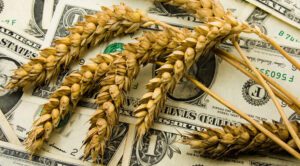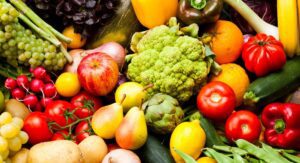
Export of agricultural products from Ukraine in the context of the Russian military invasion could reach 5 million tons per month due to increased shipments through the unblocked Black Sea ports, but an estimate of 3.5-4.5 million tons per month looks more realistic.
As reported on the website of the consulting agency Ukragroconsult on Monday, the current 2022/23 marketing year (MY, July-June) will be non-standard due to the absence of traditional seasonal export peaks that occur as the harvest progresses.
“If you look at monthly exports from the beginning of 2018/19 MY, then seasonality is clearly visible. Conventionally, Ukrainian grain exports can be divided into three stages (waves): the wheat-barley wave (begins in July-August), the first corn wave (begins in September-August). October) and the second corn wave (begins in February-March, when the supply of corn from South America disappears from the world market),” the agency said in a statement.
According to him, there will be no significant export peaks this season due to significant leftovers from last season’s harvest ready for export, but a gradual increase in shipments will be noticeable as the work of seaports normalizes.
“Current shipments from Odessa ports are still undergoing a test period, market participants are still evaluating further prospects, so it is too early to say with confidence that Ukraine will be able to fully realize its grain export potential, but exports in August may already show a significant increase,” explains ” Ukragroconsult”.
As reported, since the beginning of 2022/2023 MY, Ukraine has exported 2.98 million tons of grain crops, including 1.94 million tons of corn (65% of the total supply), 783 thousand tons of wheat (26%) and 257 thousand tons of barley (8.8%).
In addition, in July 2022, Ukraine exported 2.66 million tons of grain and oilseeds and agricultural products for export by all modes of transport, which is 22.7% more than in June.

The Mariupol Investment Group (MIG, UTA Group), which owned the UkrTransAgro sea terminal in Mariupol before the Russian military invasion, has resumed trading agricultural products through the Danube ports.
The grain trader in the current 2022/2023 marketing year (MY, July-June) has already shipped 3.14 thousand tons of wheat on barges, according to the organization’s Facebook page.
“For our company, this is an important event, since we are returning to business after losing access to the territories and the terminal itself in Mariupol (…) Now we are at the stage of formation and improvement of business processes, which will allow us to reach the design capacity for shipping up to 15 thousand tons per month. We hope that soon we will gather our former team of specialists, who are now in different parts of Ukraine,” UTA Group quotes its head Pavel Plotnikov.
The company clarified that in July this year it rented a granary with a capacity of 5 thousand tons in order to accumulate agricultural products for further export, while in the first month of operation it processed a total of 5.5 thousand tons of wheat.
As reported, the marine terminal of UkrTransAgro LLC (Mariupol, Donetsk region), which is part of the Mariupol Investment Group (MIG, UTA Group), stopped working immediately after the Russian military invasion of Ukraine on February 24.
UkrTransAgro LLC and UTA Logistic LLC are part of MIG, founded in 2007 by Oleksandr Savchuk to consolidate assets. Later, Savchuk divided the management of the main (Azovmash group) and promising (MIG) business areas.
In 2010 MIG was transformed into the management company “Mariupol Investment Group”.
MIG manages the Azov Shipyard, UkrTransAgro LLC, UTA Logistic LLC, Maritime Logistics LLC, Martlet LLC, TRK TV-7 LLC.
Transshipment of grain and oilseeds through the sea terminal of UkrTransAgro LLC in 2020/2021 MY decreased by 39% compared to 2019/2020 MY – to 430 thousand tons from 711 thousand tons.
AGRICULTURAL PRODUCTS, Danube, INVESTMENT GROUP, MARIUPOL, PORTS

The second caravan of four vessels under the Istanbul Grain Initiative left Ukrainian ports on Sunday morning, the total tonnage increased to almost 170,000 tons, sunflower oil and sunflower seeds appeared in addition to corn.
“The second caravan with Ukrainian food has just left the ports of Odessa and Chornomorsk – 3 ships from Chornomorsk and one more from Odessa. There are almost 170 thousand tons of agricultural products on board 4 bulk carriers Mustafa Necati, Star Helena, Glory and Riva Wind” , – the Ukrainian Sea Ports Administration reported on Facebook.
According to the Turkish Ministry of Defense on Twitter, the Riva Wind ship is heading to Iskenderun with 44,000 tons of corn, Mustafa Necati – to Italy with 6,000 tons of sunflower oil, Star Helena – to China with 45,000 tons of sunflower seeds and Glory – to Istanbul with 66 thousand tons of corn.
“The vessels will be anchored north of Istanbul and will be inspected by the Joint Coordination Centre,” the Turkish Defense Ministry specified.
As reported, on July 22 in Istanbul, at the proposal of the UN, Ukraine, Turkey and UN Secretary-General António Guteres signed the Initiative for the safe transportation of grain and food from the Ukrainian ports of Odessa, Chornomorsk and Yuzhny.
As part of the implementation of agreements with a cargo of Ukrainian corn, 4 ships have already been sent with more than 80 thousand tons of corn: Razoni, Navi Star, Rojen and Polarnet.
AGRICULTURAL PRODUCTS, Second caravan, UKRAINIAN PORTS, VESSELS

In July of this year, Ukraine managed to export 3.0 million tons of agricultural products, bypassing its seaports, the key export infrastructure of the country, now blocked by Russian troops.
Export growth last month was 12% compared to June 2022, according to the Facebook page of the Ukrainian Club of Agrarian Business Association (UCAB) on Monday.
In terms of crops in July, grain exports amounted to 1.7 million tons (corn – 69%, wheat – 22%, barley – 9%), having increased by 21% compared to June.
According to the UCAB, in July Ukraine exported 597.2 thousand tons of oilseeds (sunflower seeds – 61%, rapeseed – 19%, soybeans – 9%), which is 7% more than the previous month. At the same time, the same amount of vegetable oil was exported as in June – 297.1 thousand tons, of which 94% is sunflower oil and 6% is soybean.
Export of sunflower and soybean cake and meal in July amounted to 185.9 thousand tons (sunflower – 85%, soybean – 15%), which corresponds to an increase of 34% compared to June.
Thus, last month, grain crops showed the largest growth volumes, the export of which increased by almost 300 thousand tons over the month. There was also a partial change in the structure of grain exports – an increase in the share of wheat and barley compared to previous periods, which is associated with the harvesting of these crops by Ukraine and, accordingly, an increase in supply.
“Although there is a positive trend in exports, prices for grain crops in the domestic market continue to decline. They are being pressured by an excess supply of both the last year’s crop and the arrival of a new crop at a significantly lower export growth rate,” the UCAB said in a statement.
As reported, before the start of the full-scale military invasion of the Russian Federation, Ukraine monthly exported 5-6 million tons of agricultural products through its key seaports in Odessa and Nikolaev.

In June this year, Ukraine managed to export 2.7 million tonnes of agricultural products, bypassing its seaports – the key export infrastructure of the country, now blocked by Russian troops.
Export growth in June amounted to 30% compared to May, according to the website of the Ukrainian Agribusiness Club (UCAB) on Friday.
In terms of crops in June, grain exports amounted to 1.4 million tonnes (corn – 86%, wheat – 10%, and barley – 3%), having increased by 23% compared to May.
Ukraine exported in June 642,500 tonnes of oilseeds (sunflower seeds – 84%, soybeans – 14%, and rapeseed – 2%), which is 52% more than in the previous month. At the same time, vegetable oil was exported by 45% more – 298,500 tonnes, of which 94% is sunflower and 6% soybean.
Export of sunflower and soybean cake and meal in June amounted to 139,100 tonnes (sunflower – 81%, and soybean – 19%), which corresponds to an increase of 20% compared to May.
“The highest growth rates are demonstrated by oilseeds, namely sunflower seeds. For the Ukrainian market, sunflower seeds have never been an export-oriented crop. Almost the entire volume was processed in Ukraine, after which sunflower oil was exported. The situation has now changed, and it is the export of seeds that has begun to grow,” the association clarified in the message.
According to the UCAB, now the main buyers of Ukrainian agricultural products are the countries closest to Ukraine – Romania, Poland, Bulgaria and Turkey, while before the Russian invasion, the main trading partners of the country were China, India, the Netherlands and Egypt.
“The export of agricultural products needs priority in shipments by land in order to save such an important direction of Ukraine’s economy until the seaports are unblocked. Without establishing the export of all manufactured products, farmers will not have enough funds to harvest already sown crops, and even more so for the next sowing in 2023,” the association stated.
As reported, in May 2022 Ukraine exported 1.74 million tonnes of grain and oilseeds and agricultural products for export by all modes of transport, which is 1.8 times higher than in April.

Uncertainty with the export of Ukrainian grain, leading to a global food crisis and rising food prices, can be resolved by buying last year’s and this year’s crops from Ukraine for a total of $30-35 billion through a specially created fund.
This will contribute to the development of exports from the country and its internal processing in the agro-industrial complex, as well as provide the Ukrainian agricultural sector with working capital and the opportunity to continue working under the conditions of the military invasion of the Russian Federation, MP of Ukraine Dmytro Solomchuk (the Servant of the People faction) wrote on his Telegram channel on Wednesday.
“The easiest way, given the current situation, is to create the World Food Fund, collect $30-35 billion, and transfer it to Ukrainian farmers, buying last year’s and fresh products at world prices, minus logistics, on the terms of responsible storage,” he wrote.
“The world, in turn, thanks to this, will stabilize inflation, calm the beginnings of a food storm, will be motivated to organize comfortable exports, and Ukrainian farmers will receive funds for winter sowing, which will save the world in 2023, and the development of a processed industry to simplify logistics. And most importantly, the Russian Federation will stop manipulating food security,” the MP added.
As reported, on June 28, the Cabinet of Ministers of Ukraine approved a draft agreement with the UN World Food Programme (WFP) on the resumption of its office in the country, which will allow the organization, among other things, to purchase agricultural products from Ukrainian companies to carry out international humanitarian programs.